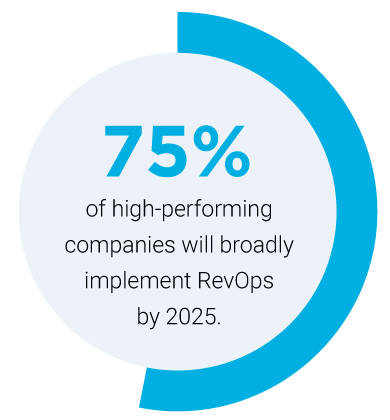B2B marketing fueled by revenue operations is undergoing a shift towards personalization, demanding a collaborative effort across departments. In the past, revenue growth strategies often relied on siloed departments and generic messaging. However, today’s business development requires a strategic, unified approach to optimize growth. Revenue operations (RevOps) has become a key topic for effective B2B marketing campaigns, fostering collaboration between marketing, sales, and customer service teams. This collaboration enhances customer experience and streamlines inbound lead generation. In this article, we will take a deep dive into the building blocks, best practices, and strategies of RevOps and how they can boost customer satisfaction and engagement. Also, the article focuses on understanding revenue operations and its impact on business performance.
What is Revenue Operations?
The revenue operations definition is to focus on creating an alignment between sales, marketing, and customer services teams into a new centralized and collaborative unit, aiming to achieve a unified goal of boosting the revenue of the organization. Effective sales and marketing involves not only reaching potential customers but also nurturing those relationships through personalized interactions and targeted messaging. By breaking down individual targets, this approach opens up communication within the prime departments and gives central access to data, goals, targets, and technologies. This enables teams to collaborate and work towards a common goal. In other words, it takes care of all the stages from where a buyer takes interest in a product or service to the company closing deals with the buyer and receiving payment.
Instead of separate teams working independently, RevOps is a more unified approach that brings these departments together. Effective sales and marketing tactics, including inbound lead generation, are required for robust revenue optimization and for implementing tech marketing strategies to increase sales. These strategies empower teams to identify, target, and capitalize on revenue opportunities, ultimately enhancing the decision-making process in business operations.
“Companies need the right technology, process, and strategy to accelerate revenue streams and efficiency”- Meredith Schmidt, EVP Revenue Cloud At Salesforce
Revenue Operations Vs Sales Operations
They sound quite similar, but there is a difference between the two approaches. Sales operations focus on maximizing an organization’s revenue by acquiring new customers. In contrast, revenue operations (RevOps) take a broader perspective, covering the entire customer lifecycle, including sales, retention, renewals, and growth through upselling and cross-selling for business development. This approach requires collaborative team efforts across departments like marketing, sales, customer service, for driving brand to demand. Additionally, incorporating sales forecasting into the revenue optimization strategy allows for more accurate planning and resource allocation, further enhancing business growth and customer satisfaction.

The Core Functions of RevOps
Aligning sales, marketing, and customer success teams
Fosters communication and coordination between the sales, marketing, and customer success departments to achieve a unified goal of understanding and meeting customer needs. This alignment involves exploring the customer journey and ensuring the proper flow of information for data-driven decision making. By engaging sales, marketing, and customer success teams, this approach helps identify hurdles in the buyer’s journey and improves interactions for enhanced customer service.
Streamlining processes and data management
With the engagement of aligned departments, it aims to manage workflows, eliminate redundancies, and identify bottlenecks to ensure the right processes are in place, fostering a culture of collaboration. This approach promotes unified accountability and trust within the organization. Additionally, the revenue operations definition is to implement the centralization of data collection and processes, ensuring everyone has access to the same information, thus enhancing informed decisions in business operations.
Utilizing technology and automation tools
Successful revenue growth of an organization is possible with data-driven decision making, which is possible with informed knowledge. To tell a clear story about your revenue pipeline, you need to connect and coordinate your technologies across your company. Revenue operations or RevOps sees technology as a tool to make things easier and faster. It uses solutions like tech marketing automation and CRM software to help teams work better, communicate more effectively, and automate tasks.

Benefits of RevOps Execution
Tech stack accessibility
Instead of using different technologies and tools by different teams, ensure the accessibility of centralized tools and technologies for everyone. This helps all sales, marketing, and customer success teams learn about buyers’ journeys and how to approach them based on their responsibilities. A similar platform increases business development by understanding customer needs, marketing solutions, and closing deals.
Customer experience and expectations
In many companies, there is a lack of coordination between departments, which limits consumer satisfaction. The limited data within departments also hampers the delivery of proper solutions to consumer needs and problems. The communication becomes more centralized and direct within the sales, marketing, and customer service teams, ensuring a flow of interaction to enhance the customer experience and boost revenue growth.
Better customer acquisition and retention
Revenue operations (RevOps) involve more than simply closing a deal; it also involves retaining the clients you have fought so hard to win. As both a sales and retention-based business, RevOps depends on both. Members of the customer success team have a deep understanding of customers because they are involved at every stage of the process. Customers are more likely to stick with your goods when you establish rapport and trust with them.
Sales enablement
Sales enablement enhances smooth processing for the marketing and sales strategy of the organization, resulting in closed deals. This ensures that the sales team and its processes are not just closing deals, but are integral to the larger revenue operations strategy. Additionally, by integrating inbound lead generation into the sales enablement strategy, organizations can attract and engage potential customers more effectively. If anything unexpected occurs, due to its centralized approach, errors could be easily found and immediately resolved.
Nine Building Blocks of RevOps Framework
Understanding the process of implementing a RevOps framework is to combine resources and build horizontal alignments between departments to streamline their go-to-market strategy. According to the book “Revenue Operations: A New Way to Align Sales and Marketing, Monetize Data, and Ignite Growth,” here are the building blocks to develop a revenue operations framework:
Revenue enablement: Revenue operations enablement includes the assets, technology, capabilities, and systems that support salespeople. These include CRM, sales enablement, content management, engagement, and readiness processing systems. Also, they encompass a wide range of tools and techniques that support daily selling objectives and workflow.
Channel optimization: Channel optimization engages processes, systems, and capabilities that increase productivity, engagement, intersections, and coverage of selling challenges in digital realms, fostering business development.
Customer-facing technology: As per the revenue operations framework, your digital selling channels such as websites, mobile apps, software, blogs, and e-commerce platforms are useful for increasing access to data and information through departments. It also includes your contactless selling, tech-marketing automation, and social media campaigns that are used for attracting and engaging your audience.
Revenue intelligence: Insights from transactions and selling data sources can help revenue managers and RevOps teams better manage growth strategies, budgets, and programs. Such intelligence also includes measurement metrics, dashboards, and analytical capabilities that helps drive for the business growth.
Customer intelligence: The software application process and capabilities that convert customer data into actionable insights and help sales teams make better conversations and decision-making, optimize campaigns, recommend actions, answer questions, and set selling priorities.
Engagement data hub: In the revenue operations framework, this refers to technologies and capabilities for transforming, aggregating, and monetizing all customer, revenue, and seller activity data from third-party systems and third-party data sources.
Talent development: All the technology process assets and capabilities that you can use to attract, develop, and retain selling talent across all functions. This includes training technologies, selling playbooks, learning management systems, sales readiness, and development software.
Revenue optimization: The technology, process, and capabilities your organization uses to optimally allocate people, time, and effort against customers and markets. It includes applications and analytics that help you define territories, set quotas, prioritize accounts, and direct demand management activities.
Revenue enhancement: The technology and process that help sellers generate more margin, revenue, and value in their interaction with customers. These include tools, capabilities, and solutions that help optimize and enhance pricing.
Road To Revenue Operations System
Each step is critical in understanding the process of implementing a RevOps framework to ensure the system is effective and beneficial for the organization. Alignment of marketing, sales, and customer service teams, fosters collaboration and enhances overall business performance to drive strategic growth.
Step 1: Accessing revenue data
Gather all information and data related to your products or services from inception to revenue acknowledgment. This includes essential components like account data, product/service details, quotations, agreements, orders, transactions, and invoices.
Step 2: Integrating the end-to-end product lifecycle
Your company uses different systems for sales forecasting, contracts, catalogs, billing, and more. Integrating end-to-end product lifecycle improves the efficiency of these systems. One strategy is to interconnect the systems, although this can pose synchronization challenges. Alternatively, integrating CRM and ERP systems provides a consolidated view, allowing every department to access a unified customer perspective.
Step 3: Streamlining tasks through automation
Manual tasks that involve duplicating data across departments can be integrated and streamlined through revenue operations. RevOps systems automate this data handling, applying validated rules and transferring information downstream. With reduced manual data handling, departments can focus on other objectives and enhance the decision-making process in business operations.
Step 4: Harnessing insights for revenue growth
Revenue operations manager and teams can help tech marketing and sales leverage customer data for informed decision-making. Analyzing customer engagement data, such as cross-channel behavior and new leads, helps develop models for optimal growth. Marketing and sales teams can use this data to understand the customer journey and target consumers when they are most likely to make purchase decisions, leading to personalization and increased revenue growth.

Smart Practices to RevOps
The implementation of best practices for revenue-generating teams can significantly boost collaboration, efficiency, and overall sales performance. Here are some smart actions based on the book “Revenue Operations: A New Way to Align Sales and Marketing, Monetize Data, and Ignite Growth.”
Visibility into the revenue cycle
The first smart action is to analyze, aggregate, and transform your customer engagement data into commercial insights, which provide better visibility into the entire revenue cycle. These insights include account health, opportunity potential, pipeline activity, and seller performance—considered four major insights sales management needs to process for successful sales.
Simplified selling workflow
In this second smart action, the selling workflow connects the dots around your revenue enablement technology portfolio such as revenue operations software to create more value and streamline the selling process. Key elements here include your core CRM and sales enablement platforms. It’s important to incorporate all systems that support the selling process, including content digital asset management, competitive intelligence CQP tools, and dynamic pricing software. Ideally, you can incorporate learning and development as well as readiness solutions to enhance your sales marketing and process delivery.
Marketing insights and frontline sellers
The third smart action involves monetizing digital selling infrastructure with account-based marketing. Synthesizing marketing signals from inside and outside your business with your CRM will help execute account-based marketing programs that optimize account coverage and maximize the return on marketing technology. Once you attach marketing signals to the account-based profiles, you can use various platforms such as CRM to engage these accounts with best-fit content.
Building a high-performing sales team
Your fourth smart action focuses on a robust revenue operations learning and development process. It unites your sales management. enablement and readiness performance to create a closed-loop system for sales representative education, coaching, reinforcement, and measurement. Sales training, playbooks, learning and development, and other methodologies are essential aspects of improving the behavior, conversation, knowledge, and education of sales representatives to win consumers.
Streamlining and personalization
The fifth smart action leverages advanced analytics and selling solutions, evolving content management into intelligent response management. This streamlined process generates and delivers contextual selling content to consumers at scale. This aligns perfectly with RevOps principles, as it utilizes AI and machine learning (ML) to create a knowledge base built on real-world question-and-answer exchanges between consumers and sales reps. Intelligent response management transforms selling assets into consumer conversations and outcomes that drive revenue growth and enhance enterprise value.
Revenue Operations: Challenges and Solutions
Implementing revenue operations can be challenging and requires careful navigation by the organization. Some common challenges and their solutions are as follows:
Siloed Data
Problem: Integrating data from different systems and departments into unified planning can be complex, especially if each department works independently with distinct management practices. For successful implementation, ensuring data transparency and breaking down these barriers is necessary.
Solution: Gathering data from each department involved in the revenue growth system deploying a centralized data hub, using standard data formats, and establishing data compliance can enhance consistency in the previously siloed data practices.
Technology Integration and Adoption
Problem: Revenue operations managers are involved in integrating several technologies and multiple systems such as marketing automation, CRM, and ERP platforms. These technological platforms and systems require specialized expertise for smoother integration and usability.
Solution: Conducting thorough technology audits to examine current systems and platforms and selecting relevant technological tools can enhance these platforms’ smoother deployment and usability.
Data Quality and Governance
Problem: Inconsistent data standards, poor data quality, and inappropriate data governance practices can be hurdles for sales and operations systems. Business organizations must prioritize data quality management and establish robust governance processes to ensure data-driven decision making based on accurate and reliable information.
Solution: Implementing quality checks and data cleansing can enhance regular auditing and ensure quality data is shared across departments. Additionally, organizations should establish strict data governance processes, including clear ownership and accountability for the data integration process.
Streamlining RevOps Strategy
Problem: Optimizing and streamlining the revenue operations strategy with best practices for revenue-generating teams can increase customer engagement, boost retention, and assist in meeting sales marketing targets. However, scaling revenue management is highly dependent on regular resource availability and efficient processes; without these, the framework can become too complicated to provide the desired outcome.
Solution: Gather information from departments to understand the requirements for resources and elements for integration. Implement automation processes to increase standardized workflows and efficiency across sales, marketing, and customer service teams. Establish best practices in data management to ensure every resource and process is available for revenue growth.
Lack of Alignment
Problem: Marketing, sales, and customer service teams often operate in siloed processes, hindering a centralized workflow, data orientation, and technological platform integration.
 If there is a lack of alignment between these departments, there can be insufficient data sharing, communication, and process improvements, resulting in missed revenue opportunities and poor customer insights.
If there is a lack of alignment between these departments, there can be insufficient data sharing, communication, and process improvements, resulting in missed revenue opportunities and poor customer insights.
Solution: Facilitate cross-functional meetings and introductions to encourage interaction among the marketing, sales, and customer service teams to foster natural dialogues. Ensure all teams use a centralized dataset and create a unified customer journey to maintain a seamless lead transition and consistent brand voice across departments. This collaborative approach strengthens revenue operations, maximizing revenue opportunities and generating valuable customer insights.
RevOps: Past, Present, and Future
In the past, marketing and sales operations were managed by systems, processes, and data independently, often without specific support. The concept of a marketing-qualified lead was focused on individuals rather than group decision-makers. Marketers tracked leads from their source to final purchase, overlooking multiple interactions and dialogue exchanges between consumers and sales reps. Database marketing managers aimed to build large contact databases for direct marketing, with little emphasis on data quality or recipient preferences. Limited technology, typically managed by IT, hindered a unified view of customers and prospects. Today, revenue operations integrate these functions, creating a more cohesive and efficient approach to managing marketing and sales processes.
Today, the marketing and sales operations team focuses on technology, data, measurement, process, and skills, enabling marketers to concentrate on core tasks. Despite these advancements, the sales and marketing teams often remain siloed. CRM and marketing automation have improved lead demand and scoring management, although they still overlook the value of buying groups. Marketers use metrics to measure revenue impacted by marketing, despite relying on arbitrary associations between deals and activities. Privacy legislation has necessitated greater attention to data management, leading to a focus on first and zero-party data. With the increasing number of technology options and tools, managing and maintaining them has become challenging due to limited expertise.
Real-time analytics and AI are expected to be critical aspects of revenue operations, allowing proactive responses to customer journey hurdles, exploring solutions, and identifying opportunities to enhance the overall experience. B2B selling will become more complex, making handling large datasets and keeping up with diverse customer touchpoints challenging. Automation, big data, and machine learning will play central roles in addressing this issue, enabling businesses to leverage accurate, timely, and manageable information for data-driven decision making. With the rapid increase in automation, analysis, and AI, the revenue teams will enhance their ability to make smart decisions across the complex customer journey, aligning brand to demand strategies for better market responsiveness and customer engagement.
Final Thoughts
Revenue operations is considered one of the crucial factors in increasing sales and success in B2B go-to-market programs. This approach unifies marketing, sales, and customer service teams, breaking down silos to streamline processes and enhance collaboration. Companies can optimize customer engagement and drive revenue growth by implementing strategic technologies, automation, and data management. Despite challenges such as technology adoption, data integration, and alignment across departments, adopting best practices, building blocks, and solutions can increase customer engagement and improve overall customer journeys. As revenue operations evolve with advancements in technologies such as AI and analytics, B2B businesses that embrace this holistic approach will be better positioned to manage complex datasets, adapt to market changes, and make data-driven decisions, ultimately ensuring sustainable growth and competitive advantage.




